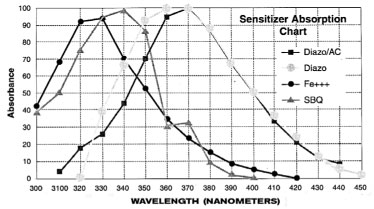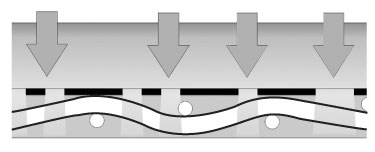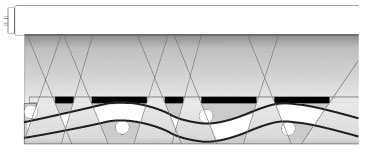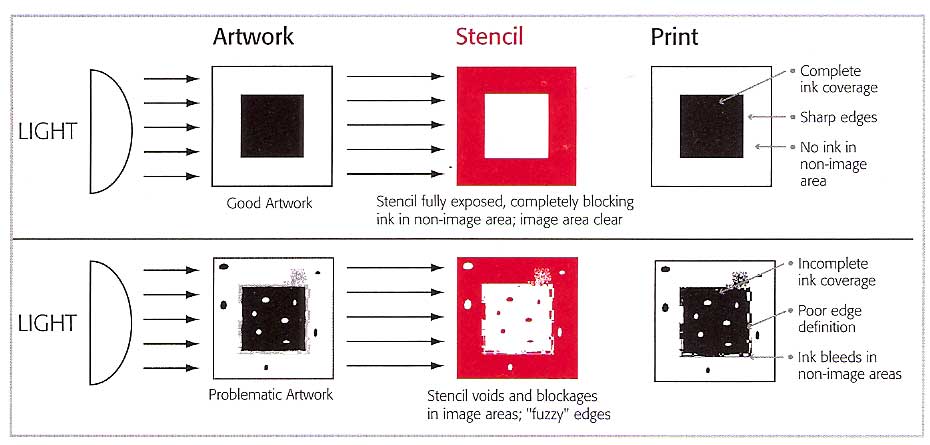- Exposure Test Video 4Mb 4 minutes
- "How Does Capillary Film Work" video - 95 Mb 17 minutes
- "How Does Direct Emulsion Work" video - 105 Mb 19 minutes
- Q1. Hazardous Identification Codes
- Q2. Presensitized emulsion shelf life and color -Blue emulsion for graphics only?
- Q3. Phthalate free
Evaluating Light Sources
Fiat lux! (“Let there be light!”), one of the earliest proclamations in the Book of Genesis, should be one of your first considerations in the creation of photographic stencils. Light sources have three main attributes. Insofar as a light source optimizes each attribute or not, it will produce stencils ranging from superb to poor.
SPECTRAL OUTPUT
The wavelengths of light, or spectral output, of an exposure source should
match closely the spectral sensitivity of photo stencil materials. The closer
the match-up, the more efficient the light source, and the better it will “cure” or
cross-link the molecules of the stencil material, so that the stencil will
be more durable. The common sensitizers used in photo films and emulsions have
specific sensitivity ranges, as shown on the “Sensitizer Absorption Chart” (below).
It’s a common misconception that photographic stencil materials are “UV-sensitive.” In
fact, they are sensitive to light ranging from upper-ultra-violet through the
visible blue part of the spectrum. (That’s why yellow lights make good
safelights, because photo stencil materials don’t react to the longer
wavelengths of yellow.)

LIGHT INTENSITY
Photo stencil materials, even those comparatively fast ones formulated for projection exposure, are not nearly as fast exposing or sensitive as camera film. If photographic stencil materials were made that fast, they would be virtually impossible to protect from “pre-exposure.” Thus, light sources need the power, the intensity, to expose stencils in a reasonably productive amount of time.
LIGHT GEOMETRY
Light geometry concerns the angle of incidence of light rays as they strike the artwork and pass through its “clear” portions into the photo stencil material. Light rays emitted from a small area or “point source”--at a minimum distance of 1½ times the diagonal of the stencil--are more nearly perpendicular as they meet the artwork and stencil (“Perpendicular Light Incidence,” back page). This affords better transfer of image and non-image information from the artwork into the photo stencil material.
By contrast, with a widely dispersed light source such as fluorescent tubes, light rays enter the stencil material at oblique angles, quite literally angled behind the dark edges of the artwork, reducing the fine detail or resolution of the stencil (“Wide Angle Incidence,” back page).
We categorize light sources according to how well they provide the three key
exposure attributes. The highest quality light sources are metal halide or
carbon arc. Mercury vapor and pulsed xenon are of medium quality. Quartz lamps,
fluorescent tubes. Grolites®, fotoflood bulbs, etc. have problematic deficiencies,
though they can be quite adequate for low resolution work, or in shops that
don’t need high stencil throughput.
 "Perpendicular" Light
Incidence
"Perpendicular" Light
Incidence
 Wide
Angle Incidence (fluorescent tube unit, top)
Wide
Angle Incidence (fluorescent tube unit, top)
All is not lost if you have a poor light source, but you will have to work
smart to compensate for it, and understand and accept the limitations imposed
by it. For help in making the most of your light source, contact Ulano Technical
Services, Brooklyn, at 1-800-221-0616. Fiat lux!
D-max, D-min, and De-lineation: Evaluating Artwork

By “artwork,” we mean any imaged media placed between a light source and photo-stencil film or emulsion during exposure. Most photographic stencils are contact exposed in a vacuum frame, so the dimensions of the artwork are the same as those of the stencil and the final print. Image setter-exposed silver film (right-reading photographic positives*), laser toner (usually on vellum), inkjet on inkjet film, thermal images, and knifecut masking film (Rubylith® brand)—all are commercial media used for contact exposure.**
The essence of screen printing is a stencil that blocks the flow of ink to non-image areas of the print and is “open” in image areas, allowing ink to flow freely through the fabric. The integrity of the stencil material and the uncompromised openness of the image areas are equally essential. In addition, there should be a clear demarcation between image and non-image areas. These attributes originate with the artwork.
Photo stencils can never be better than the artwork
used to generate them, nor can the final print be better than the stencil. If the “dark” areas of the artwork lack sufficient density*** to block light during exposure, or if they contain pinholes or ‘thin spots,” stencil material will harden in what should be the open, image areas of the stencil, and ink will not flow readily through the image areas of the stencil during printing. Similarly, if “clear” areas of the artwork are, at best, translucent rather than transparent, or contain “artifacts” such as dirt or dust, light energy will be filtered or blocked before it reaches the stencil material; non-image areas of the stencil won’t be fully “cured” or cross-linked and may break down during the printing run. Finally, if the delineation of image and non-image areas is pixilated, fuzzy, or lacking in acutance (edge sharpness or “definition”),
so will the image edges on the final print.
*Any text or other information should
be on the emulsion side of the positive and appear as you will want it to look
on the final print; the emulsion side of the positive is placed against the stencil
material during exposure.
**Projection exposure requires silver film positives that are considerably
smaller than the final size of the print. Such positives must be of very
good quality, as projection by its nature enlarges imperfections. “Computer-to-screen” systems don’t use “artwork” as we’ve defined it here. These systems either apply an image in inkjet wax directly to the stencil material (“inkjet CTS”) or utilize Texas Instruments’ digital light processing (DLP®) system to expose a screen “pixel by pixel” (“digital direct exposure”).
***The “dark” and “clear” areas of artwork can be measured on a densitometer. The opacity of the dark areas is referred to as D-max (maximum density) followed by the numeric densitometer reading. D-min refers to the minimum density—which
is a measure of the clarity of the artwork. D-max 4.0 is ideal for stencil
making, as it allows full exposure of non-image areas even if the artwork
medium is cloudy or fogged.
Q1. I can't find the NFPA codes on the Ulano MSDSheets.
A1. Ulano uses the HMIS (Hazardous Materials Identification
System) codes which can be found on on our
MSD sheets. The HMIS codes are very similar
to the NFPA and the code numbering systems are identical.
Q2. Blue emulsions for graphics only?
My supplier recently reccomended a new emulsion. He said it was blue and it doesn't need to be sensitized. Also that its unlimited shelf life and exposes twice as fast. I have always thought that blue emulsion was for graphic printing.
A2. Pre-sensitized emulsion DOES NOT have an unlimited shelf life. 12 to 18 months in controlled storage, but not unlimited.
Pre-sensitized emulsion are usually fast exposing and a favorite for beginning textile printers with inferior exposure lamps. Because of the long shelf life you can also save money buying in 5 gallon pails, not gallons.
There is some basis for saying that red colored emulsions resolve a better image, but only under the best exposure and coating conditions. Blue emulsion is not just for graphic printing. Check any listing, from any emulsion company and you will see a range of colors from blue to red and others in between.
Q3. Are Ulano products phthalate free?
A3. We are proud that all Ulano Direct Emulsions, CDF™ Direct-Films, and Presensitized (Indirect System) Photographic Films have been phthalate free since 1989. Ulano TZ emulsions, CDF™/SR-25, CDF™/TZ, UlanoCUT Green water-soluble knifecut films and all gelatin-based Photographic Films have always been phlhalate free.
Di-Butyl Plithalaie (DBP), a plasticizer present in most direct emulsions and capillary films, is under scrutiny by state and local environmental authorities. The discharge by screen printers of waste water containing DBP is severely restricted in many stales.
Ulano laboratories eliminated DBP from our photographic products in 1989 without affecting ihe reliable Ulano performance that you have come to expect.